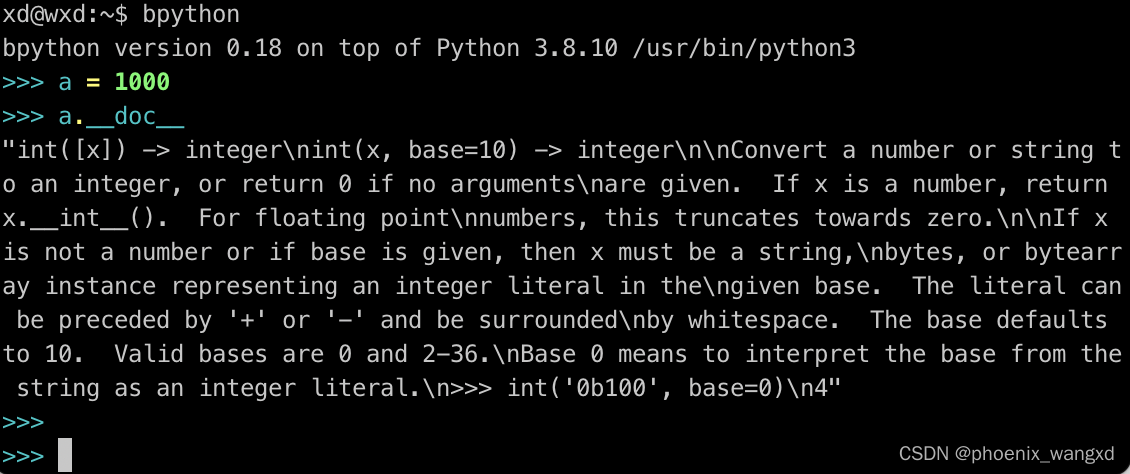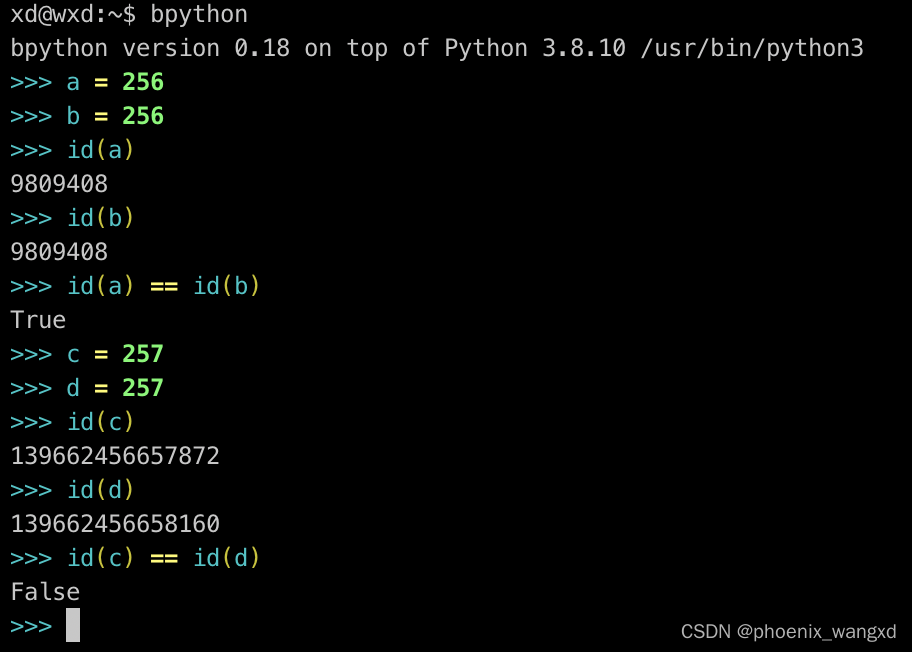0. 参考资料
本文参考资料如下:
-
B站 CPython源码分析:
P4 4.long对象解析和Hook
1. 整数类型
首先我们要有两个知识点:
- 在cpython的上层(也就是python)中看到的int型,在cpython中是以Long类型来实现的。
- 在cpython中对于整数将分为大整数与小整数两种情况进行处理
1.1. 整数对象的头文件定义
我们先看一下cpython中关于整数对象的头文件:
下面的代码摘录自: cpython源码3.8分支的
Include/longobject.h
文件中:
/* Long (arbitrary precision) integer object interface */
typedef struct _longobject PyLongObject; /* Revealed in longintrepr.h */
PyAPI_DATA(PyTypeObject) PyLong_Type;
在上面的代码中说明了
_longobject
的定义在
Include/longintrepr.h
文件,如下:
/* Long integer representation.
The absolute value of a number is equal to
SUM(for i=0 through abs(ob_size)-1) ob_digit[i] * 2**(SHIFT*i)
Negative numbers are represented with ob_size < 0;
zero is represented by ob_size == 0.
In a normalized number, ob_digit[abs(ob_size)-1] (the most significant
digit) is never zero. Also, in all cases, for all valid i,
0 <= ob_digit[i] <= MASK.
The allocation function takes care of allocating extra memory
so that ob_digit[0] ... ob_digit[abs(ob_size)-1] are actually available.
CAUTION: Generic code manipulating subtypes of PyVarObject has to
aware that ints abuse ob_size's sign bit.
*/
struct _longobject {
PyObject_VAR_HEAD
digit ob_digit[1];
};
解释:
-
PyObject_VAR_HEAD
极重要,它的介绍,可以参考我单独写的《cpython中的PyObject等对象入门》。 -
digit ob_digit[1];
: 上面的注释有详细的解释,但是先不用深入理解。 但需要知道如下信息:- 它是1维数组,默认情况下数组中只有1个元素
-
ob_digit
数组的长度与
ob_size
有着密切的关系,而
ob_size
的定义在
PyObject_VAR_HEAD
中, 表示的是可变长度对象的元素个数。
1.2. 整数对象的c代码实现
接着看一下整数对象的C代码的实现:
下面的代码摘录自: cpython源码3.8分支的
Objects/longobject.c
文件中:
PyTypeObject PyLong_Type = {
PyVarObject_HEAD_INIT(&PyType_Type, 0)
"int", /* tp_name */
offsetof(PyLongObject, ob_digit), /* tp_basicsize */
sizeof(digit), /* tp_itemsize */
0, /* tp_dealloc */
0, /* tp_vectorcall_offset */
0, /* tp_getattr */
0, /* tp_setattr */
0, /* tp_as_async */
long_to_decimal_string, /* tp_repr */
&long_as_number, /* tp_as_number */
0, /* tp_as_sequence */
0, /* tp_as_mapping */
(hashfunc)long_hash, /* tp_hash */
0, /* tp_call */
0, /* tp_str */
PyObject_GenericGetAttr, /* tp_getattro */
0, /* tp_setattro */
0, /* tp_as_buffer */
Py_TPFLAGS_DEFAULT | Py_TPFLAGS_BASETYPE |
Py_TPFLAGS_LONG_SUBCLASS, /* tp_flags */
long_doc, /* tp_doc */
0, /* tp_traverse */
0, /* tp_clear */
long_richcompare, /* tp_richcompare */
0, /* tp_weaklistoffset */
0, /* tp_iter */
0, /* tp_iternext */
long_methods, /* tp_methods */
0, /* tp_members */
long_getset, /* tp_getset */
0, /* tp_base */
0, /* tp_dict */
0, /* tp_descr_get */
0, /* tp_descr_set */
0, /* tp_dictoffset */
0, /* tp_init */
0, /* tp_alloc */
long_new, /* tp_new */
PyObject_Del, /* tp_free */
};
解释:
-
PyLong_Type
的类型是
PyTypeObject
, 这里定义了这个类型的各种具体值。-
在
tp_as_number
,
tp_as_sequence
,
tp_as_mapping
中, 只有第一个进行赋值,其余均设置为0 -
tp_doc
定义为
long_doc
- 其他还有很多,就不多介绍了
-
在
-
关于
PyTypeObject
的介绍,可以参考我单独写的《cpython中的PyObject等对象入门》。
1.3. 简单的举例说明
在上面我们介绍了python中Long类型结构体中的各种成员,其中一个是
tp_doc
, 我们可以看到
long_doc
的定义如下:
PyDoc_STRVAR(long_doc,
"int([x]) -> integer\n\
int(x, base=10) -> integer\n\
\n\
Convert a number or string to an integer, or return 0 if no arguments\n\
are given. If x is a number, return x.__int__(). For floating point\n\
numbers, this truncates towards zero.\n\
\n\
If x is not a number or if base is given, then x must be a string,\n\
bytes, or bytearray instance representing an integer literal in the\n\
given base. The literal can be preceded by '+' or '-' and be surrounded\n\
by whitespace. The base defaults to 10. Valid bases are 0 and 2-36.\n\
Base 0 means to interpret the base from the string as an integer literal.\n\
>>> int('0b100', base=0)\n\
4");
我们在交互式界面中作一个简单的测试,验证python的int类型的文档是不是这样:

可以看到完全一致。
2. python的小整数
你可能有点好奇,为什么python要将整数分为大整数与小整数两种情况来处理?
原因:在python中小整数会大量的使用到,如果每次使用时都创建对象,然后不用再释放, 这样明显会拖慢程序运行速度。所以python在初始化阶段会将一部分小整数对象实例化后,自动存放到内存池中,用的时候直接拿,不再重新申请与释放。
简要概括: 这么设计是python针对小整数的对象使用对象池技术进行的优化
下面的截图可以验证这个问题:

那么自然而然的问题是:python中到底哪些数字为小整数?
答案在:cpython源码3.8分枝的
Objects/longobject.c
文件中, 文中先定义了两个宏:
-
NSMALLPOSINTS
: 存放正的小整数 -
NSMALLNEGINTS
: 存放负的小整数
如下:
#ifndef NSMALLPOSINTS
#define NSMALLPOSINTS 257
#endif
#ifndef NSMALLNEGINTS
#define NSMALLNEGINTS 5
#endif
然后定义了方法与宏判断入参是否是小整数:
-
get_small_int
: 获取小整数 -
CHECK_SMALL_INT
: 通过定义宏来检查是否是小整数
代码:
static PyObject *
get_small_int(sdigit ival)
{
PyObject *v;
assert(-NSMALLNEGINTS <= ival && ival < NSMALLPOSINTS);
v = (PyObject *)&small_ints[ival + NSMALLNEGINTS];
Py_INCREF(v);
#ifdef COUNT_ALLOCS
if (ival >= 0)
_Py_quick_int_allocs++;
else
_Py_quick_neg_int_allocs++;
#endif
return v;
}
#define CHECK_SMALL_INT(ival) \
do if (-NSMALLNEGINTS <= ival && ival < NSMALLPOSINTS) { \
return get_small_int((sdigit)ival); \
} while(0)
3. python的大整数
我们主要看一下大整数对象申请内存的C代码的实现:
下面的代码摘录自: cpython源码3.8分支的
Objects/longobject.c
文件中:
PyLongObject *
_PyLong_New(Py_ssize_t size)
{
PyLongObject *result;
/* Number of bytes needed is: offsetof(PyLongObject, ob_digit) +
sizeof(digit)*size. Previous incarnations of this code used
sizeof(PyVarObject) instead of the offsetof, but this risks being
incorrect in the presence of padding between the PyVarObject header
and the digits. */
if (size > (Py_ssize_t)MAX_LONG_DIGITS) {
PyErr_SetString(PyExc_OverflowError,
"too many digits in integer");
return NULL;
}
result = PyObject_MALLOC(offsetof(PyLongObject, ob_digit) +
size*sizeof(digit));
if (!result) {
PyErr_NoMemory();
return NULL;
}
return (PyLongObject*)PyObject_INIT_VAR(result, &PyLong_Type, size);
}
可以看到简化后的代码就是:
-
先调用:
PyObject_MALLOC
申请内存, 原函数
PyObject_Malloc
-
再调用:
PyObject_INIT_VAR
初始化内存